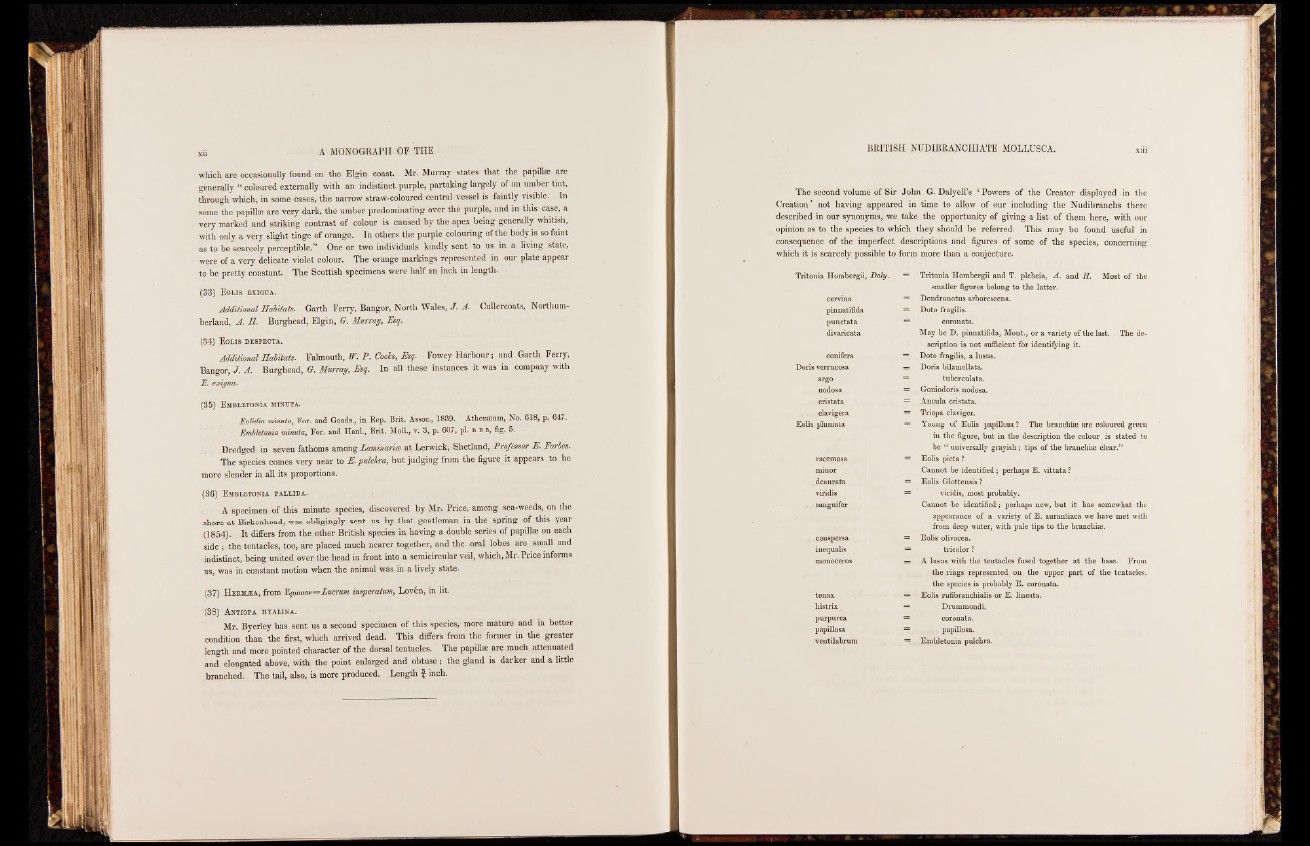
which are occasionally found on' the Elgin coast. Mr. Murray states that the papillae are
generally “ coloured externally with an indistinct purple, partaking largely of an umber tint,
through which, in some cases, the narrow straw-coloured central vessel is faintly visible. In
some the papillae are very dark, the umber predominating over the purple, and in this case, a
very marked and striking contrast of colour is caused by the apex being generally whitish,
with only a very slight tinge of orange. In others the purple colouring of the body is so faint
as to be scarcely perceptible.” One or two individuals kindly sent to us in a living state,
were of a very delicate violet colour. The orange markings represented in our plate appear
to be pretty constant. The Scottish specimens were half an inch in length.
(.33) Eolis exigua.
Additional Habitats. Garth Ferry, Bangor, North Wales, J. A. Cullercoats, Northumberland,
A. H. Burghead, Elgin, G. Murray, Esq.
(34) E olis despecta.
Additional Habitats. Falmouth. W. P. Cocks, Esq. Fowey Harbour; and Garth Ferry.
Bangor, J. A. Burghead, G. Murray, Esq. In all these instances it was in company with
E. exigua.
(35) Embletonia minuta.
Eolidia minuta, For. and Goods., in Rep. Brit. Assoc., 1839. Athenaeum, No. 618, p. 647.
Embletonia minuta, For. and Haul., Brit. Moll., v. 3, p. 607, pi. b b b , fig. 5.
Dredged in seven fathoms among Laminaria at Lerwick, Shetland, Professor E. Forbes.
The species comes very near to E. pulchra, but judging from the figure it appears to be
more slender in all its proportions.
(36) Embletonia pallida.
A specimen of this minute species, discovered by Mr. Price, among sea-weeds, on the
shore at Birkenhead, was obligingly sent us by that gentleman in the spring of this year
(1854). I t differs from the other British species in having a double series of papillae on each
side ; the tentacles, too, are placed much nearer together, and the oral lobes are small and
indistinct, being united over the head in front into a semicircular veil, which, Mr. Price informs
us, was in constant motion when the animal was in a lively state.
(37) Heb.m,ea, from Epnaiov=Lucrum insperatum, Loven, in lit.
(38) Antiopa hyalina.
Mr. Byerley has sent us a second specimen of this species; more mature and in better
condition than the first, which arrived dead. This differs from the former in the greater
length and more pointed character of the dorsal tentacles. The papillae are much attenuated
and elongated above, with the point enlarged and obtuse; the gland is darker and a little
branched. The tail, also, is more produced. Length f inch.
The second volume of Sir John G. Dalyell’s ‘ Powers of the Creator displayed in the
Creation’ not having appeared in time to allow of our including the Nudibranchs there
described in our synonyms,, we take the opportunity of giving a list of them here, with our
opinion as to the species to which they should be referred. This may be found useful in
consequence of the imperfect descriptions and figures of some of the species, concerning
which it is scarcely possible to form more than a conjecture.
Tritonia Hombergii, Daly. = Tritonia Hombergii and T. plebeia, A. and H. Most of the
smaller figures belong to the latter.
cervina ’ :=/ ■Dendronotus arborescens.
pinnatifida = Doto fragilis.
punctata = coronata.
divaricata May be D. pinnatifida, Mont., or a variety of the last. The description
is not sufficient for identifying it.
conifera ■ Doto fragilis, a lusus.
Doris verrucosa = Doris bilamellata.
argo = tuberculata.
nodosa ,: =jy Goniodoris nodosa.
cristata : Ancula cristata.
clavigera = Triopa claviger.
Eolis plumata Young of Eolis papillosa ? The branchiae are coloured green
in the figure, but in the description the colour is stated to
be “ universally grayish ; tips of the branchiae clear.”
racemosa = Eolis picta?
minor Cannot be identified ; perhaps E. vittata ?
. deaurata = Eolis Glottensis ?
viridis viridis, most probably.
sanguifer Cannot be identified; perhaps new, but it has somewhat the
appearance of a variety of E. aurantiaca we have met with
from deep water, with pale tips to the branchiae.
conspersa = Eolis olivacea.
inequalis = tricolor ?
monoceros A lusus with the tentacles fused together at the base. From
the rings represented, on the upper part of the tentacles,
the species is probably E. coronata.
tenax = .. Eolis rufibranchialis or E. lineata.
histrix = Drummondi.
purpurea ■ '= coronata.
papillosa = . papillosa.
ventilabrum ® J, Embletonia pulchra.